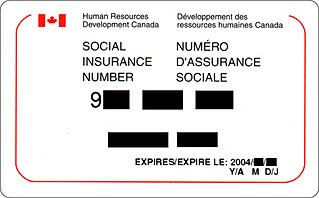Affirmative action refers to a set of policies and practices within a government or organization seeking to benefit marginalized groups. Historically and internationally, support for affirmative action has been justified by the idea that it may help with bridging inequalities in employment and pay, increasing access to education, and promoting diversity, social equity and redressing alleged wrongs, harms, or hindrances, also called substantive equality.

Apprenticeship is a system for training a new generation of practitioners of a trade or profession with on-the-job training and often some accompanying study. Apprenticeships can also enable practitioners to gain a license to practice in a regulated occupation. Most of their training is done while working for an employer who helps the apprentices learn their trade or profession, in exchange for their continued labor for an agreed period after they have achieved measurable competencies.

A social insurance number (SIN) (French: numéro d'assurance sociale (NAS)) is a number issued in Canada to administer various government programs. The SIN was created in 1964 to serve as a client account number in the administration of the Canada Pension Plan and Canada's varied employment insurance programs. In 1967, Revenue Canada (now the Canada Revenue Agency) started using the SIN for tax reporting purposes. SINs are issued by Employment and Social Development Canada (previously Human Resources Development Canada).

In macroeconomics and finance, a transfer payment is a redistribution of income and wealth by means of the government making a payment, without goods or services being received in return. These payments are considered to be non-exhaustive because they do not directly absorb resources or create output. Examples of transfer payments include welfare, financial aid, social security, and government subsidies for certain businesses.

Universities Canada is an organization that represents Canada's universities. It is a non-profit national organization that coordinates university policies, guidance and direction.
Equal pay for equal work is the concept of labour rights that individuals in the same workplace be given equal pay. It is most commonly used in the context of sexual discrimination, in relation to the gender pay gap. Equal pay relates to the full range of payments and benefits, including basic pay, non-salary payments, bonuses and allowances. Some countries have moved faster than others in addressing equal pay.
Employment and Social Development Canada is a department of the Government of Canada responsible for social programs and the labour market at the federal level. The department delivers a number of federal government programs and services including Employment Insurance (EI), Service Canada centres, Canada Student Loan Program (CSLP), Canada Pension Plan (CPP), issuing social insurance numbers (SIN) and the federal Labour Program among other things.

The Canada Labour Code is an Act of the Parliament of Canada to consolidate certain statutes respecting labour. The objective of the Code is to facilitate production by controlling strikes & lockouts, occupational safety and health, and some employment standards.
The Canadian Human Rights Commission (CHRC) was established in 1977 by the Government of Canada. It is empowered under the Canadian Human Rights Act to investigate and to try to settle complaints of discrimination in employment and in the provision of services within federal jurisdiction. The CHRC is also empowered under the Employment Equity Act to ensure that federally-regulated employers provide equal opportunities for four designated groups: women, Aboriginal people, the disabled, and visible minorities. The Commission helps enforce those human rights and inform the general public and employers of those rights.
Federal financing for small businesses in Canada is facilitated via a number of programs and agencies. Financing is available in the form of grants, loans, loan guarantees, income support and subsidized hiring and/or training programs. The government also provides funding for no-cost or subsidized services to small businesses, including workshops, business plan consulting, education, and federally sponsored trade missions. Financing, and federally funded or subsidized services are available both to established businesses looking to grow or expand into new markets and to entrepreneurs seeking to launch a new business.
The Public Service of Canada is the civilian workforce of the Government of Canada's departments, agencies, and other public bodies.
The Canada Education Savings Grant is part of a Government of Canada program, administered through Employment and Social Development Canada, to assist with savings for Canadian children's higher education. Under the CESG program, the government will contribute an amount to a Registered Education Savings Plan (RESP) according to a formula which is dependent on the amount contributed and the income level of the family making the contributions. As of 1 July 2005, the CESG is legislated by the Canada Education Savings Act.
Employment equity, as defined in federal Canadian law by the Employment Equity Act, requires federal jurisdiction employers to engage in proactive employment practices to increase the representation of four designated groups: women, people with disabilities, visible minorities, and Indigenous peoples. The act states that "employment equity means more than treating persons the same way but also requires special measures and the accommodation of differences".

Human rights in Canada have come under increasing public attention and legal protection since World War II. Prior to that time, there were few legal protections for human rights. The protections which did exist focused on specific issues, rather than taking a general approach to human rights.

The Texas Workforce Commission (TWC) is a governmental agency in the U.S. state of Texas that provides unemployment benefits and services related to employment to eligible individuals and businesses.
A statistext is a demographic category that is artificially contrived in pursuit of a political or ideological goal, particularly when categories are created that respondents would not otherwise apply to themselves. The term was created by Audrey Kobayashi, a Canadian geographer, in 1992.
The Canada Job Grant is a skill and trade training program established by the Government of Canada subsequent to the passage of the 2013 federal budget. It will be funded by the Canada Job Fund, a fund transfer from the federal government to provincial and territorial governments, which will be responsible for implementing the program. It will enable individuals to receive up to CA$15,000 in training services, funded by the federal government and the individual's employer.
According to a 2012 survey by Statistics Canada, around 3.8 million adult Canadians reported being "limited in their daily activities due to a disability". This represented 13.7% of the adult population. The three most-prevalent forms of disability in Canada are chronic pain issues, mobility, and flexibility limitations. Around 11% of Canadian adults experience one of these disability types, and 40% of those people have had all three at the same time. Disabled people in Canada have historically experienced many forms of discrimination and abuse, such as segregation, institutionalization, and compulsory sterilization. They were not given the same rights as non-disabled people until the end of the 1970s, when the Coalition of Provincial Organizations of the Handicapped initiated significant changes. Legislation intended to protect disabled Canadians include the Charter of Rights and Freedoms, the Canadian Human Rights Act, and the Employment Equity Act.

Red Seal Program, specifically known as The Interprovincial Standards Red Seal Program is a program that sets common standards for tradespeople in Canada. It is a partnership between the Canadian federal government, the provinces and the territories.
The Abella commission, officially the Royal Commission on Equality in Employment, was a Canadian federal royal commission headed by Rosalie Abella in 1983 to 1984.







